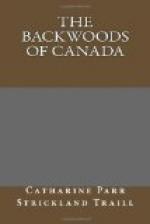How often do I wish you were beside me in my rambles among the woods and clearings: you would be so delighted in searching out the floral treasures of the place.
Deeply do I now regret having so idly neglected your kind offers while at home of instructing me in flower-painting; you often told me the time would come when I should have cause to regret neglecting the golden opportunity before me.
You proved a true prophetess; for I daily lament that I cannot make faithful representations of the flowers of my adopted country, or understand as you would do their botanical arrangement. With some few I have made myself acquainted, but have hardly confidence in my scanty stock of knowledge to venture on scientific descriptions, when I feel conscious that a blunder would be easily detected, and expose me to ridicule and contempt, for an assumption of knowledge that I did not possess. The only botanical work I have at my command is Pursh’s North American Flora, from which I have obtained some information; but must confess it is tiresome blundering out Latin descriptions to one who knows nothing of Latin beyond what she derives through a knowledge of Italian.
I have made out a list of the plants most worthy of attention near us; there are many others in the township that I am a stranger to; some there are with whose names I am unacquainted. I subjoin a slight sketch, not with my pencil but my pen, of those flowers that pleased me particularly, or that possessed any remarkable qualities.
The same plants do not grow on cleared land that formerly occupied the same spot when it was covered with forest-trees. A distinct class of vegetation makes its appearance as soon as the fire has passed over the ground.
The same thing may be remarked with regard to the change that takes place among our forests. As one generation falls and decays, new ones of a different character spring up in their places. This is illustrated in the circumstance of the resinous substance called fat-pine being usually found in places where the living pine is least abundant, and where the ground is occupied by oak, ash, buck, maple, and bass-wood.
The fire-weed, a species of tall thistle of rank and unpleasant scent, is the first plant that appears when the ground has been freed from timbers by fire: if a piece of land lies untilled the first summer after its being chopped, the following spring shows you a smothering crop of this vile weed. The next plant you notice is the sumach, with its downy stalks, and head of deep crimson velvety flowers, forming an upright obtuse bunch at the extremity of the branches: the leaves turn scarlet towards the latter end of the summer. This shrub, though really very ornamental, is regarded as a great pest in old clearings, where the roots run and send up suckers in abundance. The raspberry and wild gooseberry are next seen, and thousands of strawberry plants of different varieties carpet the ground, and mingle with the grasses of the pastures. I have been obliged this spring to root out with remorseless hand hundreds of sarsaparilla plants, and also the celebrated gingseng, which grows abundantly in our woods: it used formerly to be an article of export to China from the States, the root being held in high estimation by the Chinese.




